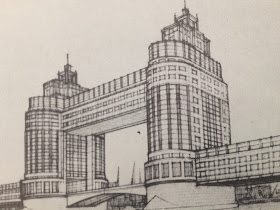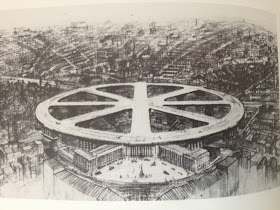I've just bought a fascinating old book, London As It Might Have Been, which collects rejected proposals for urban renewal. Some are beautiful. Some are unhinged. All reflect the socio-cultural context beautifully. For instance, the pyramids featured below all echo the Egypt-mania which gripped British society firstly after their involvement in Napoleon's Egyptian defeat, a deal which included lots of Egyptian antiquities finding their way to London (ahem) and the later British occupation of Egypt in 1882.
I don't necessarily think that any of these schemes would have been better or worse than what we have now - but they're certainly fascinating culturally and architecturally. First up: two proposals for Tower Bridge, and the final choice:
This is the proposal made in 1943. It's very Art Nouveau + Modernist, but it's also hugely optimistic: Holden drew this during the bombing campaign against London, so proposing a crystal glass tower suggests that he sees a peaceful future in the midst of the war.
Tower Bridge - a a beautiful but weird mix of Victorian mechanical engineering and medievalism, which is pretty typical of the period. Very British: hiding the modern under a 'heritage' skin.
Here are the Pyramids: the first celebrates defeating the perfidious French and would have rivalled St. Paul's Cathedral for size at a cost of £1m in 1815. It would have been built at Trafalgar Square. The second is simply an ingenious way of storing London's dead.
Once the Great Exhibition closed, people wondered what to do with the vast Crystal Palace, built entirely in sections in Smethwick and Birmingham.
Here's one wonderful, ridiculous, steampunk suggestion:
Sadly, the building was simply moved to a part of Sydenham and the area renamed Crystal Palace. It burned down in 1936.
What of other public venues? As we all know, Wembley is a seedy area dominated by a bland Global-PoMo stadium monstrosity. But in the late 19th century, plans were afoot to beat the French (again) after their Eiffel Tower grabbed the limelight. All sorts of plans were put forward, but the winner was, well, a slightly taller copy of the Eiffel Tower set amongst an ornamental garden.
The first 150ft or so got built, then the money ran out and that was it for North London's beautification. The stump was dynamited in 1907 and where it stood is now the pitch of the national football stadium. Not that the British are alone in not quite getting round to things: when the French gave the USA the Statue of Liberty, the bits and piece lay around in various exhibitions and parks in France and the US for years until the ungrateful Yankees donated enough dollar pieces to finally put the damn thing together.
Finally, what of transport? Well, the trend was techno-determinist: the machines would shape the city. So this 1960s proposal envisaged monorails above Regent Street (cool, say I), while in the early days of flight, sticking airports on top of city centre railway stations seemed very efficient.
Liverpool Street rail and air station
The combined Liverpool Street railway station and heli-pad
The Greater London Council's vision of Regent Street
It's easy to laugh at some of the more outlandish proposals, but some are genuinely visionary and quite a lot of them - especially the Haussmann-esque plans to demolish most of central London to accommodate government offices and royal palaces remind us that architects should never be left unsupervised. The airport/rail stations look to me like Albert Speer's plans to replace Berlin with the Nazi planned city of Germania, in which colossal scale replaces all humanist values. What's missing in many of the visions presented in London As It Might Have Been is any social vision. Where are Londoners - rich and poor - meant to live and work? Human interaction is forgotten.
This isn't a feature simply of rejected plans. Look at the Shard: it radiates contempt for the little people toiling below. It's a mix of a massive penis and Bentham's Panopticon. Likewise the isolated, gated communities of Docklands and the Olympic Park: they shut out the poor and privilege fear and paranoia (as Ballard's Kingdom Come and Millennium People explore). We're living in an era in which architecture follows the whims of bg money: defensiveness, arrogance, disconnection and sterility are the key signifieds of all those plate glass palaces set beyond high gates and guards. Architecture is the expression of our fantasies and fears - but it's also the creator of the same emotions.












You should read the Fantastic Journal blog (in too much of a hurry to link), he posted something a bit back showing post WW2 proposals that, amongst other things, recommended a giant multi-story car park slap bang in the middle of Trafalgar Square.
ReplyDeleteNot sure I love the pyramid fixation, but have you ever seen the Babylonian ziggurat that is the Man Power Services building in Sheffield? Regularly voted the most detested building in South Yorkshire.
Thanks Artog, I'll check out Fantastic Journal. I didn't spot the ziggurat last time I was in Sheffield, but I'm tempted to nip back there for a look. Worse than Birmingham's Central Library?
ReplyDeletehttp://www.youtube.com/watch?v=mSoa1b-yBUY&feature=related
ReplyDelete